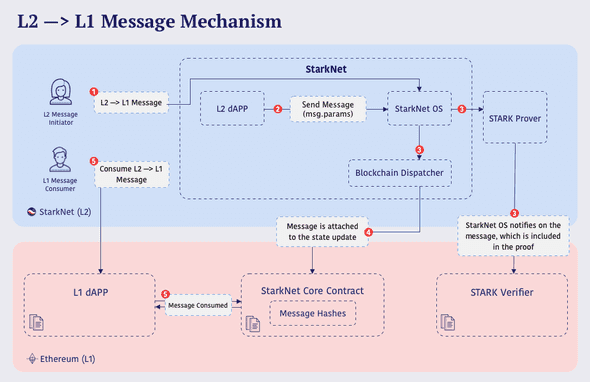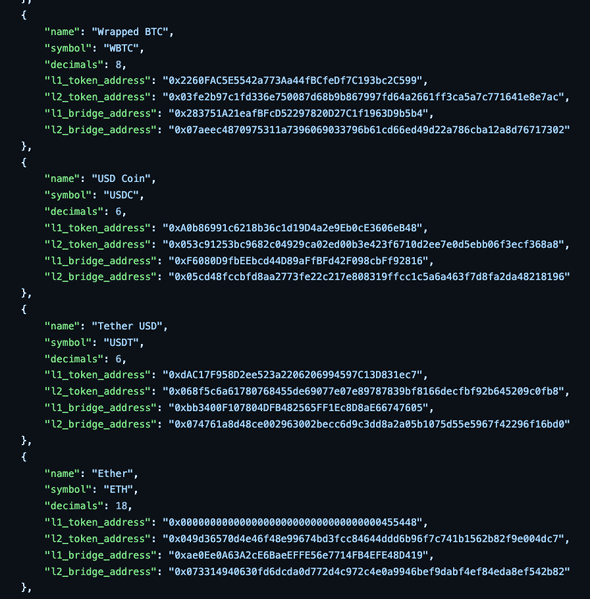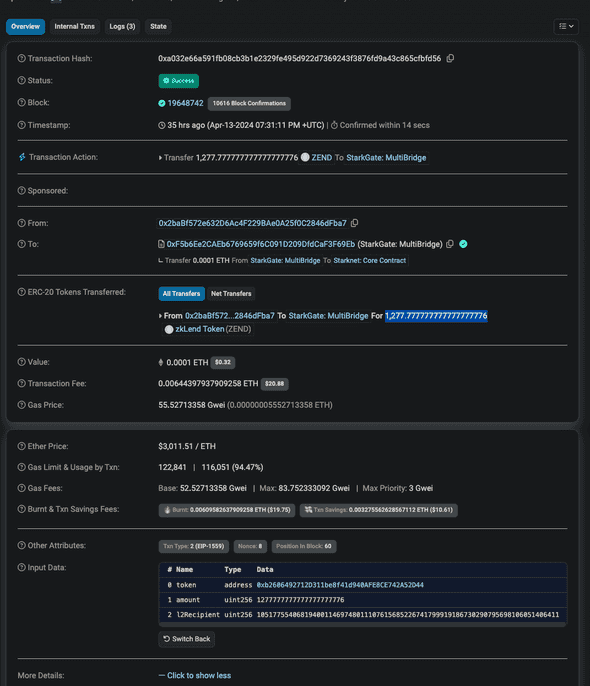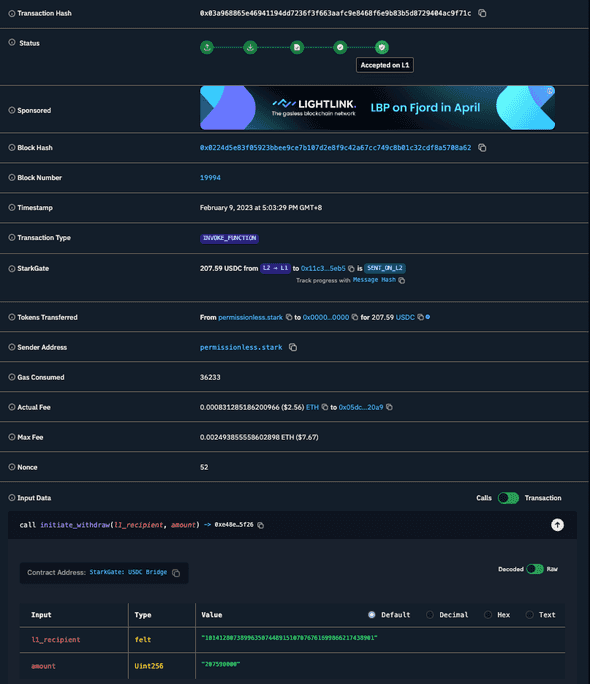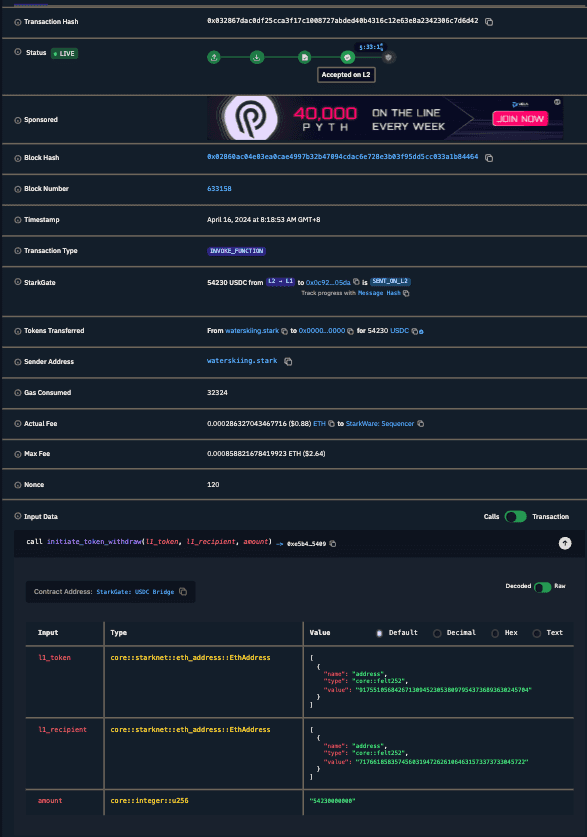Making sense of Starknet architecture and L1-L2 Messaging
March 28, 2024
⏳ 20 min read
This article was originally posted at Lazer 1 Research, which is another blog that I maintain specifically for blockchain.
With the introduction of the STRK provisions program, Starknet has garnered significant public attention, sparking a growing curiosity regarding its technical intricacies. Particularly, there exists a notable gap in understanding the architecture of Starknet and the mechanics of L1-L2 messaging. Thus, the purpose of this writing is to provide a comprehensive elucidation of these two topics.
Starknet architecture
Let us start by defining the architecture of Starknet. Starknet consists of several components:
- Mempool (Gateway)
- Sequencer
- Prover
- Full node
- Starknet core contract
- Verifier
- Starknet bridge contract
Mempool (Gateway)
A mempool (memory pool) is a temporary storage for pending transactions that are not included in a block yet. When you submit a transaction, it doesn’t go straight into the network and make changes. It will have to wait in the mempool.
The mempool performs a preliminary validation on the transaction, like checking the length of calldata.
Sequencer
Sequencer retrieves transactions from mempool and puts them in a specific sequential order, and produces blocks containing them.
In essence, a sequencer has two core tasks1:
- sequencing (ordering): it orders transactions, determining the canonical sequence of blocks for a given chain fork. It then appends new blocks to this sequence.
- executing (validation): it executes these transactions, updating the system’s state based on a given function. The block produced by the sequencer is submitted to Ethereum as a single compact proof (aka “rollup”).
Starknet has some open-source sequencers:
- Mandara
- Blockifier
- Kraken (seemingly discontinued by Lambdaclass)
A sequencer is needed in L2 blockchains for scalability and performance wins. By processing transactions off-chain in batches, it is able to achieve much faster speed.
Blockchains may have a centralized sequencer, like Starknet. The centralized sequencer can function as perfectly as a decentralized one. But the primary drive for the decentralization comes from mitigating the risk of censorship, because transactions can be reordered, included, or excluded by a centralized party without no one noticing it. In light of this, Starknet is actively moving towards decentralization, as described by their blog post in Oct 2023, although the sequencer is likely to be one of the last components in the stack to be decentralized.
Full node
Starknet has a few full node implementations:
The full node is responsible for handling all API requests specified per spec.
Prover
The prover generates proofs for the transactions in the blocks produced by the sequencer. cairo-vm is used as a prover. Another implementation is cairo-vm-go.
The prover receives blocks from the sequencer, and processes each block to assert the correctness, and generates proof, and submits the proof to Ethereum.
Starknet uses SHARP, which stands for a SHARed Prover. It is:
a powerful system designed to generate STARK proofs for aggregated Cairo programs. Cairo, being a general computation programming language, allows for the accommodation of various code logics in one single proof.
SHARP processes batches of transactions off-chain, and validates the proof for their computation on-chain, amortizing the cost of all transactions across a single proof. The generated unified STARK proof is validated through an on-chain Solidity verifier contract, enabling SHARP to enhance throughput, reduce gas fees, and minimize latency.2
In other words, different Cairo programs are run together and a single proof for all of those programs are generated. Here’s a good read on on SHARP.
Verifier
Starknet manages a verifier smart contract on Ethereum responsible for verifying the proof generated from the Cairo VM. If the proof is valid, Starknet’s state root is updated to the newest one. The verification and state transition can be seen at https://github.com/starkware-libs/cairo-lang/blob/efa9648f57568aad8f8a13fbf027d2de7c63c2c0/src/starkware/starknet/solidity/Starknet.sol#L286.
Starknet core contract
The Starknet core contract is an Ethereum contract deployed at 0xc662c410C0ECf747543f5bA90660f6ABeBD9C8c4 at time of writing. The source code can be viewed at Starknet.sol.
The core contract:
- stores the list of verifier contracts
- manages L1-L2 messaging
- oversees state commitment and update between L1 and L2
Starknet bridge contract
When we say ‘Starknet bridge contract’, it means multiple contracts that work together to enable bridging. Bridging mean not only the transfer of a token, but also any arbitrary messages between Ethereum and Starknet.
The bridge contracts can be located at:
- LegacyBridge.sol: the old bridge contract that used to be deployed per token. Still in use by most prominent tokens on Starknet, like wBTC, USDC, USDT, and more.
- StarknetTokenBridge.sol: the new bridge contract that is used to bridge multiple tokens with just one contract. Adding a token is permissionless.
- StarkgateManager.sol: manager contract that oversees tokens bridged by
StarknetTokenBridge.sol. Can deactivate or block a token, enroll a new token, etc. - StarkgateRegistry.sol: maintains the list of bridged tokens.
- token_bridge.cairo: the bridge contract on L2 that is compatible with both
LegacyBridge.solandStarknetTokenBridge.sol. Users submit withdraw requests from here. L1 bridges use this L2 contract to deposit tokens into L2. More on this later.
Architecture diagram
Below diagram helps understand how these components work together.
First, the user creates and submits a transaction to the mempool. Ths sequencer picks up the transactions from the mempool, orders, validates and executes them using Cairo VM. The Cairo program execution yields an execution trace, aggregating all the transactions appearing in that block to it. The execution trace, along with the previous state root, is fed into the prover.
The prover, again using Cairo VM, generates a new state root and proof based on the data received from the sequencer. Then it passes those to the verifier contract. The Starknet core contract verifies the validity of the state update, and if it is valid, it updates the state. Then the user’s transaction is successfully accepted on L1.
Now that we know how Starknet works, we are ready to talk about L1-L2 messaging. The Starknet bridge contract in the diagram deliberately has not been elaborated in this section for that reason.
L1-L2 messaging
Overview
Here’s an overview of L1-L2 messaging on Starknet. Here’s a diagram from Starknet’s official documentation:
Keep this in mind, as we are going to go through each step in detail in words. Then you can fully grasp the concept by coming back to this diagram later.
LegacyBridge (LegacyBridge.sol)
Starknet used to have a bridge per token. This means that for every single token that was meant to be bridged, the same bridge has to be deployed again. This bridge is still live in production and still serves most of the bridge tokens to this date. The list of tokens that make use of LegacyBridge can be discovered at https://github.com/starknet-io/starknet-addresses/blob/master/bridged_tokens/mainnet.json.
Some of them are:
You can see that each token’s bridge address is different from one another, which means that LegacyBridge is only limited to one deployment per token.
MultiBridge (StarknetTokenBridge.sol)
But deploying a bridge per token is quite troublesome, isn’t it? Ideally, it would be nice if a single bridge can handle multiple number of tokens, which means you don’t need to deploy a bridge every single time you want to bridge a new token.
This bridge is the latest standard on Starknet for any newer tokens on Starknet. Any new tokens looking for being bridged should use this contract instead.
The deployment of this bridge is managed by the StarkWare team themselves, so all you need to do is to enroll a token and use this bridge.
Enroll a token bridge
The first thing to be done is to create an ERC20 token on Ethereum. The reason we don’t do it on Starknet is that Starknet bridge contract is going to create an ERC20 contract on Starknet for us automatically once we enroll a token bridge.
Once you have your Ethereum ERC20 token address ready, you can use it to call enrollTokenBridge. Enrolling a new token bridge is permissionless. This means anyone can submit a transaction to enroll a new token bridge for any token with a small gas fee:
This relates to a few other contracts, namely StarkgateRegistry.sol and StarkgateBridge.sol (which is in fact inherited by Starknet core contract, Starknet.sol).
Let us look at the implementation of registryContract.enlistToken(token, bridge()):
It checks if there is an existing bridge for a token, or a blocked token. If it passes that check, the bridge address is assigned to the corresponding token key in the tokenToBridge mapping. This way, the registry contract maintains a mapping of token to bridge mapping.
Then, it calls enrollToken:
In sendDeployMessage, sendMessageL2 is called, and the sequencer will pick up deployMessagePayload(token) and send it to the relevant l1_handler represented by HANDLE_TOKEN_DEPLOYMENT_SELECTOR at the contract address of l2TokenBridge() on L2:
The only important line is deploy_syscall(class_hash, l1_token.into(), calldata.span(), false).unwrap_syscall();. You are deploying a new ERC20 contract, which has initially been triggered by your call to enrollTokenBridge.
Once this is complete, you will have an ERC20 contract on Starknet that corresponds to yours on Ethereum, joined together by Starknet bridge contract.
Transfer a token from L1 to L2 (deposit)
For a token using the legacy bridge, either call function deposit(uint256 amount, uint256 l2Recipient) or deposit(address token, uint256 amount, uint256 l2Recipient). The legacy bridge is designed to support the legacy function with only two parameters for backward compatibility as well as the newest function signature with three parameters:
Here’s an example transaction that deposits 69915.000000 USDC:
For a token that uses the new bridge, call deposit(address token,uint256 amount,uint256 l2Recipient). The new bridge, also called MultiBridge, is capable of handling multiple tokens with just one bridge, unlike the legacy bridge. It is deployed at 0xF5b6Ee2CAEb6769659f6C091D209DfdCaF3F69Eb on Ethereum.
Here’s an example transaction that deposits 1,277.777777777777777776 ZEND:
Do note that l2recipient is a uint256 variable because felt252 needs to fit in the variable. address won’t do it because it’s only 20 bytes, whereas felt252 will need 31 bytes. uint256 containing 32 bytes is deemed to be a suitable choice to contain felt252 variable. For those who are new with Starknet, felt252 is a variable type that can be declared in Cairo that is used to represent many things on Starknet.
Deposit code examination
Now, let’s examine the deposit function. The legacy and new ones essentially function in the same way, so we will only look into the new function.
First, notice that the function is payable, although we are depositing an ERC20 token. This is because we need to use Ether as a fee for deposit. The fee will be used by the sequencer to send the message to L2. The gas used in the deposit transaction cannot be directly used as a fee for depositing into L2. 3
Then, acceptDeposit checks if the fee is enough and transfers the specified amount of token into the contract:
The allowed range of fee is in fact hardcoded into Fee contract.
This implies that it’s not actually an estimation, but just a hardcoded value. So you don’t need to call estimateDepositFee to ‘estimate’ it. You can just hardcode your fee at some small amount of Ether that falls within MIN_FEE and MAX_FEE.
After checking the fee, we call sendDepositMessage:
require(l2TokenBridge() != 0, "L2_BRIDGE_NOT_SET"); checks whether the L2 bridge address is set. In the case of MultiBridge, this will be the corresponding MultiBridge contract (token_bridge.cairo) on Starknet, currently deployed at 0x0616757a151c21f9be8775098d591c2807316d992bbc3bb1a5c1821630589256.
Then, we make sure the amount is non-zero by writing require(amount > 0, "ZERO_DEPOSIT").
The next line is possible due to using UintFelt252 for uint256; directive at the top of the contract code. UintFelt252 is a small library to manage Felt252 data type. So we just make sure that l2Recipient is a valid L2 address by writing require(l2Recipient.isValidL2Address(), "L2_ADDRESS_OUT_OF_RANGE");.
If you have been following well, you should notice that bool isWithMsg = selector == HANDLE_DEPOSIT_WITH_MESSAGE_SELECTOR; should be false, because the selector that is being passed down is HANDLE_TOKEN_DEPOSIT_SELECTOR which is not HANDLE_DEPOSIT_WITH_MESSAGE_SELECTOR because we don’t have any message - it is an empty array.
We create a payload using depositMessagePayload function. Everything that is relevant to the transaction (in this case, deposit) that the user is making needs to be included in the payload, because it will be an input to generate a hash that represents L1 to L2 message hash.
Failure to include all relevant information in the payload will result in a message hash from which certain information cannot be confirmed. For example, if you deposited 500 USDC but if the amount of 500 USDC is not reflected in the hash, there is no proof on blockchain that you deposited 500 USDC anymore.
When withMessage == false, the payload would be [token, msg.sender, l2Recipient, amountLow, amountHigh]. The reason we encode the amount into low and high variables is that the amount is a variable of type uint256, which means it cannot be represented by felt252 which is only 31 bytes. To be able to represent that information on Starknet, we divide it into two variables, which would have been fine if we were to only care about Ethereum.
If withMessage == true, the payload would contain [token, msg.sender, l2Recipient, amountLow, amountHigh, message.length, message[0], message[1], ..., message[message.length - 2], message[message.length - 1]]. As such, a user can send an arbitrary length of message along with the token.
Finally, we call sendMessageToL2 from the Starknet core contract. Let’s look at how sendMessageToL2 is implemented in that contract:
The function first increments the nonce. The nonce is very important in this context, because it prevents the transactions of the same payload to be differentiated from one another. Remember that the payload can contain [token, msg.sender, l2Recipient, amountLow, amountHigh] in its simplest form. Then, if the msg.sender sends the same amount of a token to the same l2Recipient more than once, the same message hash will be produced if a unique nonce is not included in the hash.
After incrementing the nonce, the hash is derived by using getL1ToL2MsgHash:
Notice that everything related to the current transaction is included in the hash to avoid any hash collisions.
Once Starknet sequencer detects the transaction by waiting for enough L1 confirmations for it, it initiates the desired L2 transaction by invoking the relevant function in token_bridge.cairo marked with #[l1_handler].
Depending on the existence of the message, the sequencer will pick up the transaction and call handle_deposit or handle_deposit_with_message:
The first thing to note is that only_from_l1_bridge asserts that the deposit is always from the L1 bridge. l1_handler’s first parameter is always the address of the L1 contract that initiated the transaction, which is being used to validate only_from_l1_bridge. Failure to do so will directly result in a security vulnerability, because anyone can forge a deposit payload and call sendMessageToL2 in the Starknet core contract with it. That means anyone might be able to mint a token to L2 without having to prove that they have a token on L1.
The only authoritative deposit is from the L1 bridge, which is a separate contract from the core contract. The L1 bridge could be any of the addresses specified as l1_bridge_address at https://github.com/starknet-io/starknet-addresses/blob/master/bridged_tokens/mainnet.json.
In case of handle_token_deposit, we just need to increase the token balance of the l2_recipient. This is done by handle_deposit_common:
permissioned_mint is a function that is present in the ERC20 contract deployed by Starknet core contract. We will cover this later on. For now, it’s enough to know that it mints a token to l2_recipient.
If a deposit contains a message, handle_deposit_with_message will be invoked instead. After calling handle_deposit_common, the next procedure is just invoking on_receive of l2_recipient with the calldata containing the information about the deposit, which is [l2_token, amount, depositor, message].
This feature is called ‘smart deposit’, where the deposit moves funds from L1 to L2 and then triggers subsequent actions. If on_receive isn’t implemented or fails to return true, handle_deposit_with_message will not succeed, and the fund will have to be recovered with depositWithMessageCancelRequest because there is no way it can be received by l2_recipient anymore.
Once one of these l1_handlers successfully run, the l2_recipient should be able to see the increase in the amount of the token on its wallet.
Later on, l1ToL2Messages are processed altogether at the same time at the Starknet core contract, when the state is being updated to reflect the relevant transaction that just happened on L2:
The programOutput is the execution result of StarkNet OS program that encompasses multiple Cairo programs that were processed at a time.
processMessages will enter the else branch at line 116. Then, msgFeePlusOne for each message will be accessed to add to totalMsgFees. Right after that, messages[messageHash] = 0 to specify that the corresponding message has been consumed to L2.
Transfer a token from L2 to L1 (withdraw)
The withdrawal begins by calling either initiate_withdraw or initiate_token_withdraw in token_bridge.cairo:
Here’s a transaction that calls initiate_withdraw for 207.59 USDC:
Do note that this is from some time ago, on Feb 9, 2023, which is the reason that the transaction is a call to the legacy function initiate_withdraw. But the upgraded legacy bridges also now support initiate_token_withdraw, which has the exact same functionality. Although the legacy function still works, it is left there for backward compatibility. Any new applications should strive to use initiate_token_withdraw wherever possible.
So here’s a transaction that calls initiate_token_withdraw on 54230 USDC:
Mainly, two things are happening:
- The L2 token is being burnt by
permissioned_burn. - A message is being sent to L1 by
send_message_to_l1_syscall. The message payload always contains[0, l1_recipient, l1_token, amount].0is used to mean a ‘transfer from Starknet’.
Once the message arrives at L1, its hash will be stored in l2ToL1Messages (which in the body of function processMessages below, is supplied as a parameter called messages):
Starknet core contract will iterate through every message from L2 to L1 and store each in its messageHash. We observe that messages[messageHash] += 1; because we want to signify that the message has been received. It is possible that messages[messageHash] > 1 in case of the same withdrawal request. Also, note that we do not have a nonce here unlike deposit. The reason is that we don’t need to differentiate one withdrawal from another if they are of the same l1_recipient, l1_token and amount.
As for deposit, nonce makes each instance of deposit unique. For example, if you deposited 500 USDC at 3PM and another 500 USDC at 4PM with the exact same l2_recipient, somehow the deposit at 4PM might have worked and 3PM might have not. In that case, the two deposits are not the ‘same’ anymore, and the distinct instance of deposit at 3PM needs to be cancelled. As per the dev’s comment:
On the other hand, withdrawal cannot be cancelled, so there is no reason to keep track of nonce for it.
Once processMessages is triggered by the sequencer to update the state, the withdrawal request should now be placed in l2ToL1Messages. If so, recipient at L1 can now call withdraw to claim the bridged token:
We can see that consumeMessage just creates the payload that we saw in initiate_token_withdraw already and calls consumeMessageFromL2. TRANSFER_FROM_STARKNET is set to 0, which is in line with what we have done on L2:
Finally, consumeMessageFromL2 at Starknet core contract derives the hash with keccak256(abi.encodePacked(fromAddress, uint256(uint160(msg.sender)), payload.length, payload)). If the hash exists, we subtract 1 away from l2ToL1messages[msgHash] to tell that this msgHash has been fully consumed.
Once the message is consumed, the fund is transferred to the recipient suing transferOutFunds. At this point the recipient should be able to see a change in the balance on its wallet.
Indexing withdrawal initiations
Now, if you are an dApp builder who wants to provide withdrawal functionality to users, you would need to track the calls to initiate_token_withdraw at L2 because users will need to use the parameters of initiate_token_withdraw as an input to generate message hash to access l2ToL1messages later on L1.
This means you would need some off-chain indexer that does this. You can simply keep track of the event emitted from initiate_token_withdraw, which is:
Then, the indexer would at times query l2ToL1messages[msgHash] to see if the message is ready for consumption at L1 by constructing msgHash from the information given from WithdrawInitiated events. If l2ToL1messages[msgHash] > 0, the frontend can display an option to submit a transaction for withdraw at L2.
In fact, this is the current implementation of Starkgate, a full-stack bridge software maintained by StarkWare. It constantly checks if you have a pending withdrawal by querying an off-chain indexer hosted at starkgate.starknet.io/transfer-log/api/* once you enter the website and connect your wallets:
Once it detects that you have a pending withdrawal, you will have a little toast that tells you to submit a transaction to complete the withdrawal of your fund on L1.
Withdrawal limit
The Starknet bridge contract implements something called ‘withdrawal limit’ or ‘withdrawal quota’. So far we have seen a few lines of code where it enforces some rule related to it, but didn’t bother to explain there.
The withdrawal limit can be enabled by a designated security agent only. This means even ERC20 token contract owners cannot enforce a withdrawal limit. It is only enabled when the security determines that there is a serious security issue that may bring about withdrawals of unsual amount.
References
- The Starknet Book
- Mandara architecture
- Joining Forces: SHARP - Save Costs and Enhance Ethereum’s Scalability: If it’s Written in Cairo, SHARP Can Prove it
- Starknet Community Call #35 | SHARP - the backbone of Starknet
- SHARP: StarkWare’s Shared Prover | Kineret Segal
- Starknet Glossary
- Transaction lifecycle
- Starknet architecture review
- Starknet architecture
